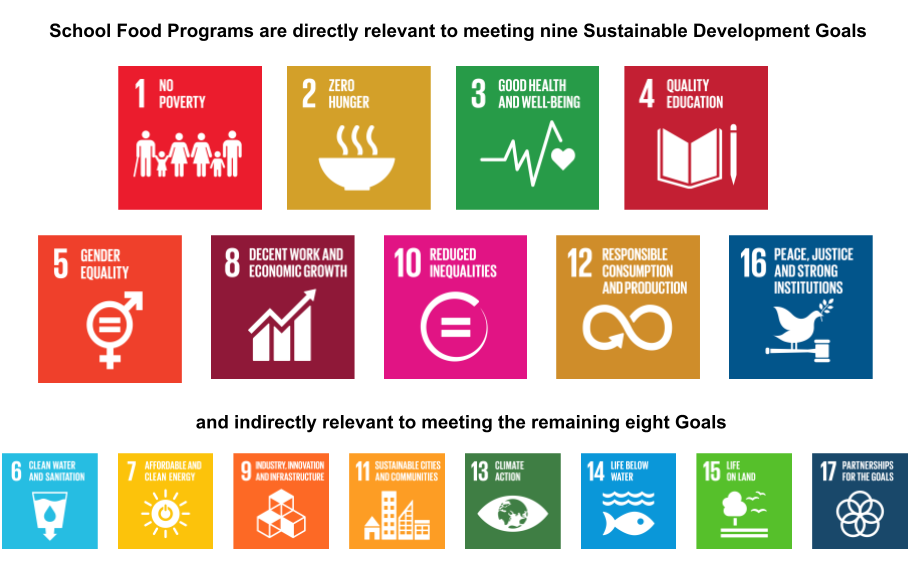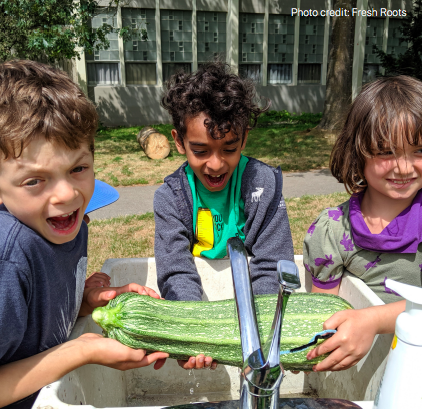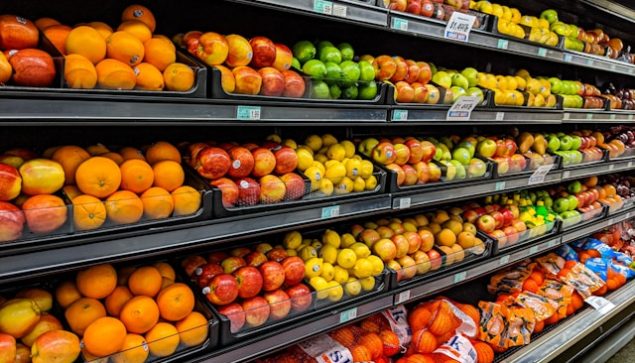Canada is committed to meeting the 17 Sustainable Development Goals (SDGs) by 2030. Launched in 2015, the SDGs provide a roadmap to advance the health of people and the planet.
In 2019 the Government of Canada announced that it will work towards a National School Food Program. This was later made an action area of the Food Policy for Canada. The Government intends to measure the success of the Food Policy using targets aligned with the SDGs.
How could a national school food program help Canada advance its SDG commitments? And how could Canada design school food programs so that they best advance the SDGs?
How Goals and targets are met by school food programs depends on how the programs are designed. A well-designed, comprehensive program will have the most potential to achieve multiple Goals and targets. Read the discussion paper below, which provides an overview of how school food programs and teh SDGs can advance one another.

How school food programs can meet 14 specific SDG targets
School food programs can directly impact 14 SDG global targets associated with 9 directly relevant Goals:
| Goal 1 – End poverty in all its forms everywhere | |
| Target 1.2 By 2030, reduce at least by half the proportion of men, women and children of all ages living in poverty in all its dimensions according to national definitionsSchool food programs do not directly address the economic causes of food insecurity but they can reduce the pressure on the family budget by covering the cost of meals at school. | |
| Target 1.3 Implement nationally appropriate social protection systems and measures for all, including floors, and by 2030 achieve substantial coverage of the poor and the vulnerableWhen they are universal, school food programs are part of a social protection system that reaches all children in all communities, except those not in school by exclusion or choice. | |
| Goal 2 – End hunger, achieve food security and improved nutrition and promote sustainable agriculture | |
| Target 2.1 By 2030, end hunger and ensure access by all people, in particular the poor and people in vulnerable situations, including infants, to safe, nutritious and sufficient food all year round.Universal healthy school food programs reach students across household income levels, ensuring equitable access to nutritious food for all students. | |
| Target 2.3 By 2030, double the agricultural productivity and incomes of small-scale food producers, in particular women, indigenous peoples, family farmers, pastoralists and fishers, including through secure and equal access to land, other productive resources and inputs, knowledge, financial services, markets and opportunities for value addition and non-farm employment.School food programs can create predictable, structured markets for small farmers, reduce their investment risks and provide them with a regular source of income. | |
| Target 2.4 By 2030, ensure sustainable food production systems and implement resilient agricultural practices that increase productivity and production, that help maintain ecosystems, that strengthen capacity for adaptation to climate change, extreme weather, drought, flooding and other disasters and that progressively improve land and soil qualitySchool food programs have enormous potential to advance sustainable regional food systems, through procurement standards. | |
| Goal 3 – Ensure healthy lives and promote well-being for all at all ages | |
| Target 3.4 By 2030, reduce by one third premature mortality from non-communicable diseases through prevention and treatment and promote mental health and well-being.School meal programs offer a unique setting to influence the diet choices and health behaviours of children and mitigate risk for chronic disease later in life. | |
| Goal 4 – Ensure inclusive and equitable quality education and promote lifelong learning opportunities for all | |
| Target 4.1 By 2030, ensure that all girls and boys complete free, equitable and quality primary and secondary education leading to relevant and effective learning outcomesSchool food programs benefit student learning and academic success. | |
| Target 4.7 By 2030, ensure that all learners acquire the knowledge and skills needed to promote sustainable development, including, among others, through education for sustainable development and sustainable lifestyles, human rights, gender equality, promotion of a culture of peace and non-violence, global citizenship and appreciation of cultural diversity and of culture’s contribution to sustainable developmentSchool food programs that include food and nutrition literacy education can help to educate students about sustainability and engage them in more sustainable actions. | |
| Goal 5 – Achieve gender equality and empower all women and girls | |
| Target 5.4 Recognize and value unpaid care and domestic work through the provision of public services, infrastructure and social protection policies and the promotion of shared responsibility within the household and the family as nationally appropriateSchool food programs support parents, especially working women, in the preparation of at least one meal per day for their children, and along withw universal child care programs can be part of a comprehensive approach to equity and support for women. | |
| Goal 8 – Promote sustained, inclusive and sustainable economic growth, full and productive employment and decent work for all | |
| Target 8.1 Sustain per capita economic growth in accordance with national circumstances and, in particular, at least 7 per cent gross domestic product growth per annum in the least developed countriesSchool food programs can create sustainable, climate-friendly jobs at the school, on-farm and in local processing. | |
| Goal 10 – Reduce inequality within and among countries | |
| Target 10.2 By 2030, empower and promote the social, economic and political inclusion of all, irrespective of age, sex, disability, race, ethnicity, origin, religion or economic or other statusMeals and curriculum that focus on cultural diversity provide opportunities for students to learn about diverse cultures and to engage in their own cultural practices. | |
| Goal 12 – Ensure sustainable consumption and production patterns | |
| Target 12.3 By 2030, halve per capita global food waste at the retail and consumer levels and reduce food losses along production and supply chains, including post-harvest lossesSourcing food locally and engaging students in growing, gathering and cooking can reduce both plate waste (when students like the food and want to eat it more) and production waste. | |
| Target 12.7 Promote public procurement practices that are sustainable, in accordance with national policies and prioritiesSchool food programs can support local food production strategies by procurement standards and cultivating strong relationships between schools, community partners, and local food producers. | |
| Goal 16 – Promote peaceful and inclusive societies for sustainable development, provide access to justice for all and build effective, accountable and inclusive institutions at all levels | |
| Target 16.7 Ensure responsive, inclusive, participatory and representative decision-making at all levelsWhen students, parents, school staff, and local stakeholders such as farmers and local municipalities are involved in the design and evaluation of school food programs they bring communities together to create more inclusive societies. |
School food programs can contribute to meeting the other 8 goals indirectly
Goal 6 (Clean water and sanitation): Food literacy programs can educate children to understand why water access and management is vital.
Goal 7 (Affordable and clean energy): School food programs that commit to sourcing all or some of their produce from sustainable farming help to create demand that supports farm transformation.
Goal 9 (Industry, Innovation and Infrastructure): Schools can build or retrofit school kitchens and gardens to be sustainable and fully accessible, as well as provide a reliable market for small and local food processors.
Goal 11 (Sustainable Cities and Communities): Urban school garden projects contribute to targets around green space, and building inclusive and sustainable urbanization.
Goal 13 (Climate Action): School food programs can model menus that are healthy for children and the planet, teach about the impact of our food choices on greenhouse gas emissions, teach about and reduce food waste, provide a market for sustainable, climate-friendly agricultural produce, and teach about how to grow food sustainably.
Goal 14 (Life below water): School food programs can support sustainable fisheries through their food purchasing decisions, as well as food literacy.
Goal 15 (Life on land): School food programs can support land use and biodiversity protection targets through menu choices, school garden projects and food literacy.
Goal 17 (Partnerships for the goals): Canada highlighted its longstanding support to the World Food Program’s school meals feeding programs in its 2018 Voluntary National Review of progress towards meeting the 2030 Agenda.
Read more in Food Secure Canada’s 2021 Discussion Paper School Food and the Sustainable Development Goals: A pathway to meeting multiple goals and targets
Acknowledgement: This discussion paper has been developed in part thanks to funding from Employment and Social Development Canada (ESDC)’s Sustainable Development Goals (SDG) Funding Program. The views expressed in this briefing paper are not necessarily those of ESDC or the Government of Canada.
Thanks to Susan Alexander, Policy Advisor at Food Secure Canada, to Lindsay Goodridge, Master of Public Health MPH (‘21) who contributed research and wrote the evidence summaries for this paper as part of her practicum placement with the Coalition for Healthy School Food, and to other staff and consultants of FSC and CHSF who contributed to this paper.
How to cite this paper: Food Secure Canada (2021). School Food and the Sustainable Development Goals: A pathway to meeting multiple goals and targets. Available from https://foodsecurecanada.org/2021/07/07/school-food-and-the-sustainable-development-goals-a-pathway-to-meeting-multiple-goals-and-targets/

